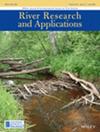分析河床自然水位动态,减轻河流干预对形态的影响
IF 1.9
4区 环境科学与生态学
Q4 ENVIRONMENTAL SCIENCES
引用次数: 0
摘要
为了维护安全、生态或航运,通常需要对河道进行局部干预,如缩小河道或修建边沟。在高排水量和低排水量期间,这些干预措施会对河床形态产生不同的影响。绘制不同排水量的河床水位变化图并了解这些影响可为多功能河流的干预设计提供新的机遇。在任何时刻,河流的局部河床水位都由发生在不同时空尺度上的河床水位变化组成。这些变化包括大尺度的河床侵蚀/退化趋势、中尺度的河床水位变化(由排水量波动引起)以及小尺度的移动河床形态(如沙丘)。我们以荷兰瓦尔河为案例,分析了因排水量波动而导致的中期河床水位变化(动态部分),并对洪泛区干预措施的设计提出了调整建议,以尽量减少可能对当地河床水位变化造成的负面影响。我们考虑了案例研究中两条 10 公里河段 16 年(2005-2020 年)的河床水位时间序列。通过小波变换,我们分离出了由排水事件引起的河床水位变化。这些河床水位变化根据排水事件的规模进行展示,并编入河流形态动力学互动图集,使我们能够减轻干预措施的影响。这将有助于河流管理者设计干预措施,改善多功能河流的管理、运行和维护。本文章由计算机程序翻译,如有差异,请以英文原文为准。
Analyzing natural bed‐level dynamics to mitigate the morphological impact of river interventions
Local river interventions, such as channel narrowing or side channels, are often necessary to maintain safety, ecology, or navigation. Such interventions have different effects on the river's bed morphology during periods of high‐ and low‐discharge events. Mapping the bed‐level variations for different discharge levels and understanding these effects can provide new opportunities for the design of interventions in multifunctional rivers. At any moment, the local bed level in a river is composed of bed‐level changes that occur at various spatial and temporal scales. These changes consist of bed aggradation/degradation trends on a large scale, on an intermediate scale bed‐level variations as a result of discharge fluctuations, and on small‐scale moving river bed forms like dunes. Using the river Waal in the Netherlands as a case study, we analyze the intermediate‐term bed‐level changes resulting from discharge fluctuations (dynamic component) and propose adaptations to the design of floodplain interventions such that possible negative impact on the local bed‐level changes is minimized. Time series of bed levels along two 10 km stretches of the case study are considered for a period of 16 years (2005–2020). Using a wavelet transform, we isolate bed‐level variations resulting from discharge events. These bed‐level variations are presented based on the magnitude of the discharge event and are compiled in an interactive atlas of river morphodynamics, allowing us to mitigate the impact of interventions. This will help river managers in the design of interventions and lead to improved management, operation, and maintenance of multifunctional rivers.
求助全文
通过发布文献求助,成功后即可免费获取论文全文。
去求助
来源期刊

River Research and Applications
环境科学-环境科学
CiteScore
4.60
自引率
9.10%
发文量
158
审稿时长
6 months
期刊介绍:
River Research and Applications , previously published as Regulated Rivers: Research and Management (1987-2001), is an international journal dedicated to the promotion of basic and applied scientific research on rivers. The journal publishes original scientific and technical papers on biological, ecological, geomorphological, hydrological, engineering and geographical aspects related to rivers in both the developed and developing world. Papers showing how basic studies and new science can be of use in applied problems associated with river management, regulation and restoration are encouraged as is interdisciplinary research concerned directly or indirectly with river management problems.
 求助内容:
求助内容: 应助结果提醒方式:
应助结果提醒方式:


